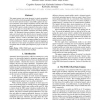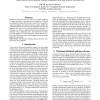ICASSP
2011
IEEE
14 years 4 months ago
2011
IEEE
The use of speaker adaptation transforms as features for speaker recognition is an appealing alternative to conventional short-term cepstral features. In general, this kind of met...
125
Voted
ICASSP
2011
IEEE
14 years 4 months ago
2011
IEEE
This paper investigates the impact of subspace based techniques for acoustic modeling in automatic speech recognition (ASR). There are many well known approaches to subspace based...
120
Voted
TNN
2010
14 years 7 months ago
2010
Abstract--A set of Artificial Neural Network (ANN) based methods for the design of an effective system of speech recognition of numerals of Assamese language captured under varied ...
INTERSPEECH
2010
14 years 7 months ago
2010
This paper presents our recent advances in speech recognition based on surface electromyography (EMG). This technology allows for Silent Speech Interfaces since EMG captures the e...
100
Voted
INTERSPEECH
2010
14 years 7 months ago
2010
Multilingual speech recognition obviously involves numerous research challenges, including common phoneme sets, adaptation on limited amount of training data, as well as mixed lan...
INTERSPEECH
2010
14 years 7 months ago
2010
Log-linear models have recently been used in acoustic modeling for speech recognition systems. This has been motivated by competitive results compared to systems based on Gaussian...
98
Voted
INTERSPEECH
2010
14 years 7 months ago
2010
This paper presents a method for rescoring the speech recognition lattices on-the-fly to increase the word accuracy while preserving low latency of a real-time speech recognition ...
74
Voted
INTERSPEECH
2010
14 years 7 months ago
2010
Phonetic decision trees are a key concept in acoustic modeling for large vocabulary continuous speech recognition. Although discriminative training has become a major line of rese...
100
Voted
INTERSPEECH
2010
14 years 7 months ago
2010
In this paper, we present a systems approach for channel modeling of an Automatic Speech Recognition (ASR) system. This can have implications in improving speech recognition compo...
97
Voted
INTERSPEECH
2010
14 years 7 months ago
2010
Sparse Component Analysis is a relatively young technique that relies upon a representation of signal occupying only a small part of a larger space. Mixtures of sparse components ...






